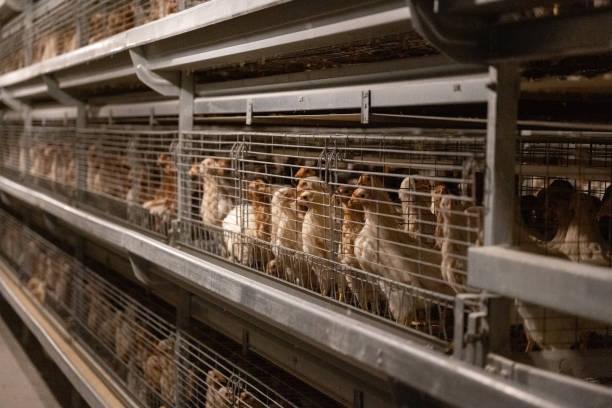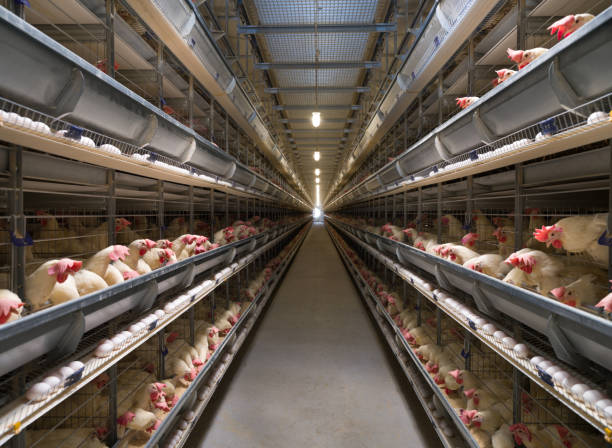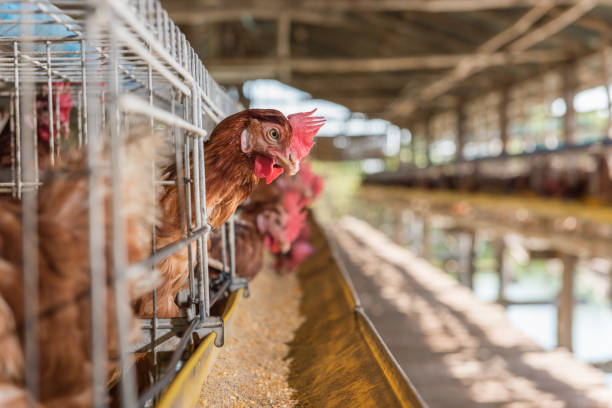
90,000 Layers: Optimizing Your Poultry Business with Efficient Cage Systems
90,000 Layers: Optimizing Your Poultry Business with Efficient Cage Systems
For poultry farmers looking to scale up, managing a 90,000-layer operation is no small feat. It needs meticulous planning, efficient resource management, and smart technology investments to ensure profitability and sustainability. One of the most critical decisions is choosing the right cage system. Efficient cage systems can significantly optimize your poultry business, leading to increased egg production, reduced labor costs, and improved bird welfare. So, let’s dive deep into how you can achieve this.
Understanding the Landscape of a Large-Scale Layer Operation
Before we delve into the specifics of cage systems, it’s important to understand the nuances of managing a 90,000-layer farm. Such a large operation requires:
Significant Investment: This includes land, housing, equipment, and the birds themselves.
Strategic Planning: From feed management to waste disposal, everything needs to be meticulously planned and executed.
Skilled Labor: You’ll need a team competent in poultry management, health monitoring, and equipment maintenance.
Market Access: Establishing reliable channels for selling your eggs is crucial.
Compliance: Meeting local regulations and standards concerning animal welfare and environmental protection is mandatory.
Only when you have a firm grasp of these core aspects can you even begin to think about your cage systems.
Why Choose Cage Systems for Your 90,000 Layers?
While alternative farming methods like free-range are gaining popularity, cage systems still offer significant advantages, especially when dealing with large-scale operations:
Higher Stocking Density: Cage systems allow you to house more birds in a given area, maximizing space utilization.
Improved Egg Production: Birds in cages tend to lay more eggs due to controlled environments and reduced stress from predators and other environmental factors.
Easier Management: Cage systems make it easier to monitor individual bird health, manage feeding and watering, and collect eggs.
Reduced Disease Spread: Cages help prevent the spread of disease by limiting bird-to-bird contact and facilitating easier cleaning and disinfection.
Lower Labor Costs: Automated feeding, watering, and egg collection systems can significantly reduce labor requirements.
Different Types of Cage Systems for Layers
Once you’ve decided that cage systems are right for your operation, you’ll need to choose the type of cage that best fits your specific needs and budget. Here are the most common options:
A-Frame Cages: A-frame cages are a traditional and relatively inexpensive option. They are arranged in rows, with cages stacked on top of each other in an A-shape. Manure usually falls onto the floor and needs to be cleaned manually or with automated scrapers.

Pros: Low initial cost, simple design, easy to maintain.
Cons: Manual manure removal can be labor-intensive, may not provide optimal bird welfare compared to newer systems.
H-Frame Cages: H-frame cages are similar to A-frame cages but are designed to be taller and more robust. This allows for better ventilation and easier access to the birds.
Pros: Better ventilation than A-frame cages, easier access to birds.
Cons: Higher initial cost than A-frame cages, still requires manure management.
Layer Battery Cages: Battery cages are a highly intensive system consisting of rows and tiers of small cages. Battery cages typically feature automated feeding, watering, and egg collection.
Pros: High stocking density, automated systems reduce labor costs, better control over the environment.
Cons: High initial investment, potential animal welfare concerns, may face regulatory restrictions in some regions.
Enriched Cage Systems (Furnished Cages): Enriched cages are designed to improve bird welfare by providing more space and enrichments such as perches, scratching areas, and nesting boxes.
Pros: Improved bird welfare, meets higher animal welfare standards, can command premium prices for eggs.
Cons: Higher initial cost than traditional battery cages, requires more space per bird, more complex management.
Vertical Layer Cages: Vertical layer cages are modern cage systems designed to maximize space utilization in the poultry house, featuring multiple tiers of cages stacked vertically.
Pros: Maximum space utilization, efficient automated systems, improved bird welfare, reduced disease spread, and lower operational costs.
Cons: Higher upfront investment, some designs might need more training to manage.
Key Considerations When Choosing a Cage System
Choosing the right cage system involves considering several factors to ensure that it aligns with your business goals and values:
Budget: Determine how much you can invest in a cage system. Consider not only the initial cost but also the long-term operating costs, such as energy consumption and maintenance.
Stocking Density: Decide on the optimal stocking density for your birds. Higher stocking densities can increase egg production but may also compromise bird welfare and increase the risk of disease.
Automation: Assess the level of automation you need. Automated feeding, watering, and egg collection systems can significantly reduce labor costs.
Bird Welfare: Give high priority to bird welfare when choosing a cage system. Enriched cages or aviary systems can improve bird welfare by providing more space and enrichments.
Manure Management: Evaluate your options for manure management. Automated manure removal systems can reduce labor costs and improve hygiene.
Climate Control: Consider the climate in your region and choose a cage system that provides adequate ventilation and temperature control to ensure optimal bird health and productivity.
Local Regulations: Be aware of local regulations and standards concerning animal welfare and environmental protection. Choose a cage system that complies with these regulations.
Future Scalability: Envision your potential growth. Can the system be easily expanded if you decide to increase your flock size in the future?
Optimizing Your Poultry Business with Efficient Cage Systems
Once you’ve selected and installed your cage system, the next step is to optimize your poultry business to maximize egg production and profitability. Here are some key areas to focus on:
Feed Management: Provide a balanced diet that meets the nutritional needs of your laying hens. Adjust the feed composition based on the age and stage of production.
Water Management: Ensure that your birds have access to clean, fresh water at all times. Monitor water consumption to detect any potential health problems.
Lighting: Effective lighting is crucial for egg production. Implement a proper lighting program to stimulate egg laying.
Ventilation: Good ventilation is essential for maintaining air quality and preventing the build-up of harmful gases.
Temperature Control: Maintain a comfortable temperature range for your birds. Extreme temperatures can negatively impact egg production and bird health.
Health Management: Implement a comprehensive health management program to prevent and control diseases. Regularly monitor your birds for signs of illness.
Egg Handling: Handle eggs carefully to prevent damage and contamination. Implement proper egg collection, cleaning, and storage procedures.

Record Keeping: Maintain detailed records of egg production, feed consumption, mortality, and other key performance indicators. This data can help you identify areas for improvement.
The Benefits of Automation in Cage Systems for 90,000 Layers
For an operation of this size, automation is not just a luxury, it’s a necessity. Here’s how automation can transform your poultry business:
Automated Feeding Systems: Ensure your birds receive the right amount of feed at the right time, reducing waste and improving feed conversion ratios.
Automated Watering Systems: Provide a consistent supply of fresh water, minimizing the risk of dehydration and disease.
Automated Egg Collection Systems: Reduce labor costs and improve egg quality by automatically collecting eggs from the cages and transporting them to a central collection point.
Automated Manure Removal Systems: Regularly remove manure from the poultry house, improving hygiene and reducing the risk of disease.
Climate Control Systems: Automatically adjust ventilation, temperature, and humidity levels to maintain optimal conditions for your birds.
Monitoring and Control Systems: This allows you to remotely monitor and control various aspects of your poultry house, such as temperature, humidity, lighting, and feed consumption.
Addressing Animal Welfare Concerns in Cage Systems
Animal welfare is an increasingly important consideration for consumers and regulators. While traditional cage systems have been criticized for their impact on bird welfare, there are steps you can take to improve the well-being of your hens within a cage environment:
Enriched Cages: As mentioned earlier, enriched cages provide more space and enrichments such as perches, scratching areas, and nesting boxes.
Proper Stocking Density: Avoid overcrowding by maintaining a low stocking density in your cages.
Environmental Enrichment: Provide enrichments such as pecking blocks, dust baths, and manipulable objects to encourage natural behaviors.
Humane Handling: Train your staff on humane handling techniques to minimize stress during handling and transportation.
Regular Monitoring: Monitor your birds regularly for signs of stress or illness. Address any problems promptly.
Veterinary Care: Work with a veterinarian to develop a comprehensive health management program that prioritizes animal welfare.
Sustainability in Large-Scale Layer Operations
With growing environmental concerns, sustainability is also crucial for large-scale layer operations. Here are some ways to make your 90,000-layer farm more environmentally friendly:
Energy Efficiency: Use energy-efficient lighting, ventilation, and heating systems to reduce your carbon footprint.
Water Conservation: Conserve water by using efficient watering systems and implementing water recycling programs.
Waste Management: Properly manage manure and other waste products to prevent pollution. Consider composting or anaerobic digestion to convert waste into valuable resources.
Sustainable Sourcing: Source feed ingredients from sustainable suppliers.
Reduce, Reuse, Recycle: Implement the 3Rs of waste management to minimize your environmental impact.
Renewable Energy: Invest in renewable energy sources such as solar or wind to power your farm.
Making the Transition Smoothly
Transitioning to efficient cage systems for a 90,000-layer operation involves careful planning and execution. It’s not just about installing new cages; it’s about optimizing your entire operation to maximize its potential. By choosing the right cage system, optimizing your management practices, and embracing technology, you can create a thriving poultry business that is both profitable and sustainable. Remember to stay informed, adaptable, and always prioritize the health and well-being of your birds.
